Welcome to
Information Transmission Laboratory
(Tachikawa Laboratory)
Research Fields:
Communication Theory
Spread Spectrum
Code Division Multiple Access
Orthogonal Frequency Division Multiplexing
Power Line Communication
Wideband System
Other Communication Systems
![]() Spread Spectrum Communication Systems
Spread Spectrum Communication Systems
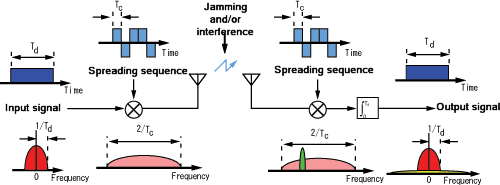
- Spread Spectrum modulation technique must satisfy the 2 conditions
below:
(1) The transmitted signal bandwidth is much greater than the information bandwidth.
(2) Some function other than the information being transmitted is employed to determine the resultant transmitted bandwidth.
- The process of spreading the bandwidth offers a combination of advantages
not available in other communication systems. These advantages
include:
(1) Anti-interference, anti-jamming
The dispreading process at the receiver reduces the detrimental effects of interference due to jamming, and interference arising from other users of the channel.
(2) Multiple access capability
The anti-interference characteristics of spread spectrum makes it suitable for multiple access capability. Several users can simultaneously communicate over a common channel by providing different PN sequences for each user. These PN sequences provides only a small co-channel interference between the users.
(3) Message privacy/security
Since the information-bearing signal is transmitted far in excess of the minimum bandwidth necessary to transmit it, the transmitted signal is buried in the background noise making it difficult for an unintended listener to detect or intercept or even know that a communication is taking place. This characteristic is also called low probability of intercept.
(4) Multipath protection
The desired signal and the delayed signal due to multipath propagation can be resolved at the correlation process specially when the time delay exceeds the chip duration. A maximal ratio combining can then be applied to the resolved signals. This combination method is referred to as RAKE reception.
- Spread Spectrum systems fall into 4 major categories:
(1) Direct Sequence systems:
Direct sequence spread spectrum systems are so called because they employ a high speed code sequence, along with the basic information being sent for modulation.
(2) Frequency hopping systems:
The wideband frequency spectrum desired is generated in a different manner in a frequency hopping system. It does just what its name implies. That is, it hops from frequency to frequency over a wide band. The specific order in which frequencies are occupied is a function of a code sequence, and the rate of hopping from one frequency to another is a function of the information rate.
(3) Time Hopped systems:
Time hopped spread spectrum systems have found no commercial application to date. However, the arrival of cheap random access memory (RAM) and fast micro-controller chips make time hopping a viable alternative spread spectrum technique for the future
(4) Chirp systems. :
Chirp systems are often employed in radar systems and only used in commercial spread spectrum systems.
Multiple Access Communication Systems
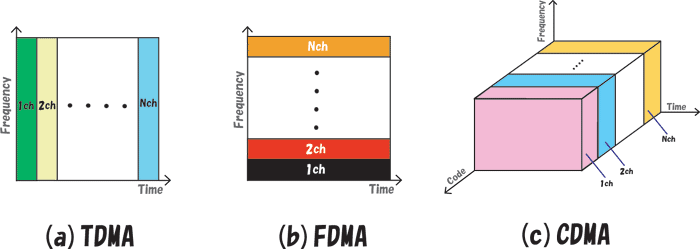
Common methods of providing multiple access capability are Frequency Division Multiple Access (FDMA), where each user is assigned a particular frequency channel, and Time Division Multiple Access (TDMA), where each user is assigned a particular time slot within a time frame. When all frequency channels in FDMA and time slots in TDMA are occupied, the system has reached its capacity and no additional users can be accommodated.
The third class of multiple access techniques is the Code Division Multiple Access (CDMA) which is based on the spread spectrum technology. In this technique, each user is assigned a particular code, that is, either a particular PN sequence or a particular frequency hopping pattern.
![]() Power Line Communications
(PLC)
Power Line Communications
(PLC)
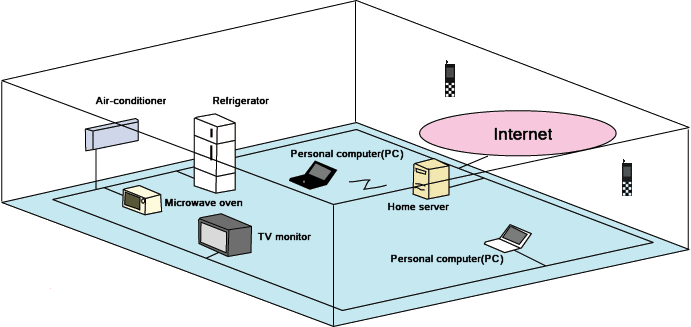
The data transmission techniques on a residential electric power line provide some available communication systems because they give a facile construction of network, high cost-performance, neat wiring, and so on. Recently, direct sequence / spread spectrum (DS/SS) system and orthogonal frequency division multiplexing (OFDM) system have been considered as applicable techniques for power line communications (PLC). However, in the poor environment of power lines, it is difficult for both systems to guarantee quality of service (QoS). Therefore, it is necessary to study power line communications further.
![]() Multi-Carrier Modulation
Systems
Multi-Carrier Modulation
Systems
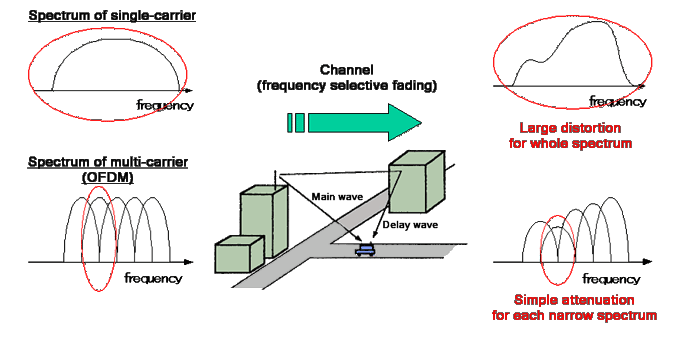
Orthogonal Frequency Division Multiplexing (OFDM) is an important method of multi-carrier modulation systems. The spectral efficiency becomes high by dense frequency arrangement. And the hardware can be realized simply by employing Inverse Fast Fourier Transform (IFFT) as modulation and Fast Fourier Transform (FFT) as demodulation. Each carrier is varied by a flat fading which is not a frequency selective fading. The distortion of waveform is little, only simple attenuation of signal arises. The combination techniques of OFDM and CDMA have been proposed and studied.
![]() Ultra Wide-Band Systems
Ultra Wide-Band Systems
UWB systems use carrierless, short-duration (picosecond to nanosecond) pulses with a very low duty cycle for transmission and reception of the information. A simple definition for duty cycle is the ratio of the tike that a pulse is present to the total transmission time. There are 2 sorts of UWB technologies.
(1) Ultra Wide-Band Impulse Radio (UWB-IR): UWB-IR is carrier-less. It sends and receives impulse-like pulses (duration from 1[ns] to several hundreds [ps]).
(2) This method utilizes multi-carrier techniques like Spread Spectrum technologies or Orthogonal Frequency Division Multiplexing (OFDM). Sometimes it utilizes a combination of several modulation methods.
UWB systems have several advantages, for example, coexistence with current narrowband and wideband radio services, resistance to jamming, highly secure communications, and so on.
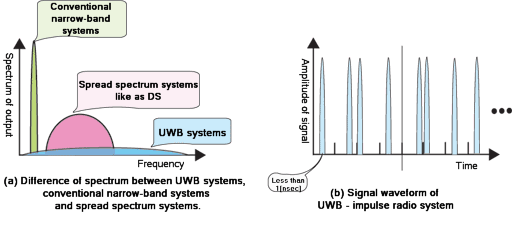
------------------------------------------------------------------------------------------------------------------------------
Shin'ichi Tachikawa
was born in
Tel:+81-258-32-6435
Fax:+81-258-34-9700
Tachikawa Laboratory,
Depertment of Electronic Control Engineering,
National Institute of Technology, Nagaoka College,
888 Nishikatakai, Nagaoka, Niigata,
940-8532,
Tel:+81 258-32-6435 (ext. 249)